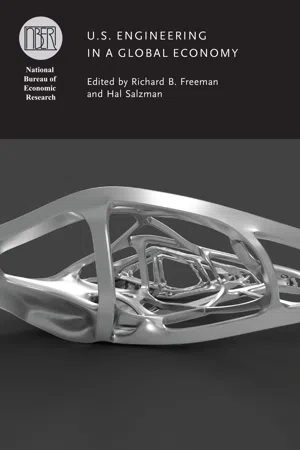![]()
1
The Engineering Labor Market
An Overview of Recent Trends
Daniel Kuehn and Hal Salzman
1.1 Introduction
The role of engineers in developing infrastructure, technology, and innovation has long made the economic health of the profession an issue of concern for public policy. In the Great Depression, engineers were critical in developing the New Deal public infrastructure that boosted employment. In World War II, engineers were critical in advancing military technology and deploying it in the field, which raised national security concerns about bottlenecks due to limited supply (Allen and Thomas 1939). After the war, many saw engineers and scientists as vital to national security and economic prosperity. In 1945, Vannevar Bush (an engineer himself) articulated the need for a strong science and engineering workforce in his famous statement on the “Endless Frontier” of scientific and technological progress (Bush 1945). For most of the next several decades, policymakers worried about shortages of engineers and scientists.1 Shortage fears reached a crescendo in 1957, when the Soviet Union’s launch of Sputnik seemed to threaten U.S. technological preeminence. But economists found little evidence of a classic market “shortage” in labor market data on wages, employment, and graduates (Arrow and Capron 1959; Blank and Stigler 1957; Hansen 1967). Ensuing work recognized that the labor market for engineers functions differently from labor markets where demand and supply clear markets quickly because engineering education requires intensive and highly prescribed curriculum, causing supply to lag demand, and that because firms cannot easily find substitutes for engineering skills, wages may be driven up considerably in the short term, producing resultant cobweb-type cycles not found in most labor markets (Freeman 1975, 1976; Ryoo and Rosen 2004).
Still, labor shortage fears have persisted into the twenty-first century (Teitel baum 2014), perhaps most notably in the National Academy of Science and National Research Council’s report, Rising above the Gathering Storm. Invoking Churchill’s characterization of Germany’s threat to Europe in his book, The Gathering Storm, the report was written to raise an alarm about the growing threat to the United States by the rise of other nations’ science and technology capabilities and insufficient U.S. investment in its own research and development (R&D). Warning that “The nation must prepare with great urgency to preserve its strategic and economic security” (National Academy of Science et al. 2007, 4), the report recommended increasing the number of engineering graduates to keep up with the large numbers graduating in countries such as China. As with the earlier post–World War II cries of shortage and calls for more engineers, these recommendations lacked clear and convincing evidence of unmet domestic demand.2
This chapter provides background information on the engineering workforce and trends in the supply of new engineers to the labor market that set the stage for the rest of the book.
The chapter begins with an overview of the engineering workforce and the changes in its detailed occupational composition and distribution across industries over time. Since demand is thought to generally lead supply in this market, we then review the factors influencing the demand for engineers. This includes changes in the demand for engineers across industries, fluctuations in government demand, and replacement demand. This discussion provides context for interpreting trends in the supply of new engineers with undergraduate degrees and graduate degrees from American colleges and universities, which are presented in section 1.3.
The data in the demand section come from the decennial census, the American Community Survey (ACS), the Bureau of Labor Statistics’ Occupational Employment Statistics (OES), and the National Science Foundation’s (NSF) semiregular Scientists and Engineers Statistical Data System (SESTAT) that combines information from three NSF surveys, the National Survey of College Graduates, the National Survey of Recent College Graduates, and Survey of Doctoral Recipients (SDR) to construct a nationally representative sample of college-degree holders. The chapter focuses on the subset of degree holders in the SESTAT data who earned at least one degree in an engineering field, but it uses ACS and OES data rather than SESTAT for time-series analysis due to changes in the SESTAT sampling frame.3 The data in the supply section comes from the Integrated Postsecondary Education Data System (IPEDS), which collects detailed annual enrollment and graduation information from the approximately 6,700 postsecondary institutions that accept federal financial aid.
While there is value in analyzing all persons with engineering degrees regardless of where they work, or all persons who report working in an engineering occupation regardless of their education, many of these analyses using the SESTAT and ACS are restricted to persons working as engineers with engineering degrees. These restrictions make the SESTAT analyses more comparable to the IPEDS data. This leaves out engineering graduates who work in other occupations4 and persons who say they work in an engineering occupation but do not have a bachelor’s degree in engineering.5 The OES data cannot be restricted by field of degree.
1.2 The Engineering Workforce: Demand and Salaries
An engineer is defined by the Bureau of Labor Statistics—across the various subfields—as a worker who designs, develops, and tests solutions to technical and physical problems faced by industry and government. Although popular analyses and policymakers typically refer to engineers as a single group, with the assumption that this represents a more or less homogeneous workforce and labor market, it is instead a remarkably heterogeneous workforce in terms of education, skills, industry representation, and work performed. Civil engineers, for example, are primarily involved in construction work and employed in independent engineering firms and government (“public administration” is the title used in standard industrial classification statistics). In contrast, aerospace engineers are seldom self-employed or employed by engineering firms, working instead for large aerospace manufacturing firms. Since aerospace engineers are reliant on large military and civilian aviation industry contracts, they are less affected by normal business cycle dynamics than civil engineers whose work is directly affected by levels of construction activity. Mechanica...
